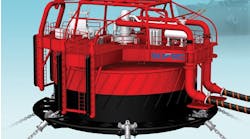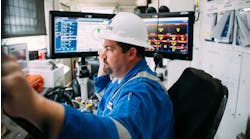A group of oil and gas majors is supporting the development of cryogenic floating flexible pipelines for LNG transfer operations.
The venture is a direct follow-on from the qualification of such flexibles in aerial architectures through the Amplitude-LNG Loading System joint industry project (JIP).
The possibility of a marine terminal for LNG transfer, similar to those existing for crude oil, opens new scenarios for the industry at both the liquefaction and re-gasification ends of the chain. The marine transfer facilities can be located outside the usual port or river facilities and linked to the coast using long-length, cryogenic pipe-in-pipes, developed and qualified recently by Technip.
Alternatively, for isolated gas fields with on-site liquefaction facilities (LNG-FPSO), the floating flexibles could be used to connect the FPSO to the mid-ship manifolds of the LNG carriers.
The floating flexibles are being developed on a step-by-step basis, which started with the IFP/Principia DeepLines program extension to analyze the behavior of flexibles when floating on the sea surface. Modeling of floating pipes must take into account the change of buoyancy for surface-piercing elements. To do so, the immersed volume must be derived at all times from the interrelating impact of the sea surface taking into account wave elevation and the actual pipe geometry.
The initial results from the program were positive, and within the framework of the Floating Flexible JIP - again supported by various majors. A second phase started in 2005 that included model basin trials (at 1/10th scale) in the Oceanide basin in La Seyne, southern France.
To date, 150 tests have been performed covering a wide range of configurations. Initially, the focus was on current-only tests to calibrate the drag Cd and inertial Cm coefficients to be incorporated into the models. Then, comparisons were made with irregular wave tests to validate the numerical results for both extreme and fatigue conditions. The tests revealed a good correlation between statistics for forces and vertical motions for both extreme and fatigue conditions.
The final step of the JIP involves building and testing in open-sea conditions a floating flexible prototype (8-in. or 16-in. I., 50 m long). The prototype will be fully instrumented to record motions, bending radius, tension and number of cycles, and a data recording buoy will be anchored alongside to record actual oceano-meteo data. The latter will be input into the DeepLines program and the results compared with the actual results from the monitoring system in the flexible.
The objective is to derive a model that can predict the lifetime of such flexibles in a set of given marine conditions. Micro leaks through the inner stainless steel bellows will be the determining factor. The use of multi-layer bellows gives an extended fatigue life for flexibles in constant motion on the sea-surface.
For more information contact[email protected].
In brief...
SEDI Fibers Optique has introduced a range of optical fiber connectors that address hermetic feedthrough issues associated with harsh environment sensor and data communications applications. These include ST connectors for all types of silica fibers, from 140 to 1,000 microns; FC/APC for single mode fibers; and polarization maintaining FC for PM fibers.
The company also offers customized products with no fiber discontinuity. All products are tested in house for hermetic properties with pressure values ranging from a few millibars to 1,000 bar.
Institut de Soudure, France’s national welding institute, has established a new welding center at the Qatar Science & Technology Park. This is providing research, training and export services to assist forthcoming oil and gas projects in the region - the costs of welding and metallurgy are a major concern.
The institute has been active in Qatar since 2003, supervising welding on the 370-km (230-mi) Dolphin gas pipeline installation between Qatar and the UAE. With over $133 billion of projects planned for Qatar over the next five years, the institute plans to establish its international headquarters for oil and gas research in the country.





